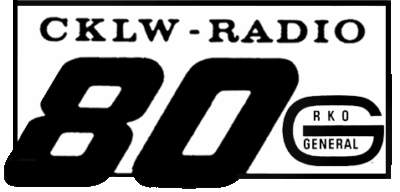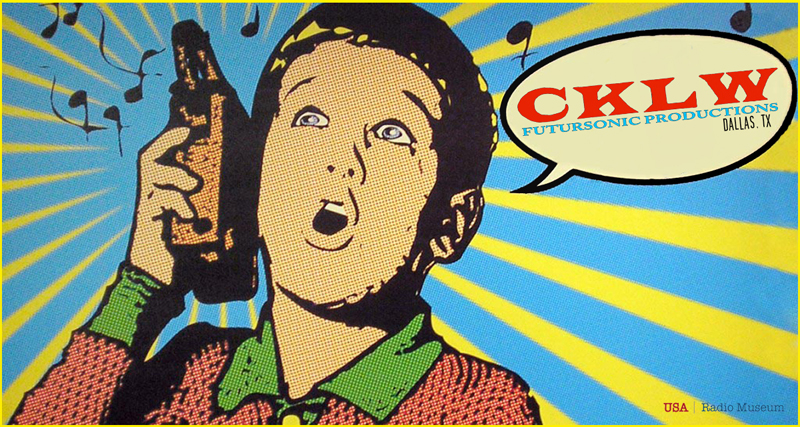CKLW 1963: Futuresonic’s Sound Before the Storm In 1963, before CKLW roared to life as “The Big 8,” its sound carried a different kind of c
CKLW 1963: Futuresonic’s Sound Before the Storm
In 1963, before CKLW roared to life as “The Big 8,” its sound carried a different kind of charge—bright, melodic, and curiously refined. These echoes didn’t come from chart-topping hits alone, but from the brief brilliance of a jingle production house known as Futursonic. Based in Dallas and helmed by the visionary Tom Merriman, Futursonic wove vocal harmonies and orchestral arrangements into tight, functional sound bites that transformed ordinary station identifiers into unforgettable moments of radio artistry.
 For CKLW, serving Detroit’s sprawling audience from across the Windsor border, Futursonic’s package wasn’t just a branding tool—it was a sonic blueprint. It captured the station’s cross-cultural energy, hinted at its coming transformation, and gave listeners a soundtrack for their day that was as musical as the hits it introduced. The jingles didn’t just fill time—they made time feel important.
For CKLW, serving Detroit’s sprawling audience from across the Windsor border, Futursonic’s package wasn’t just a branding tool—it was a sonic blueprint. It captured the station’s cross-cultural energy, hinted at its coming transformation, and gave listeners a soundtrack for their day that was as musical as the hits it introduced. The jingles didn’t just fill time—they made time feel important.
This is the story of a sound caught mid-transition: part jazz-inflected sophistication, part youthful propulsion. It’s the story of Futursonic at its zenith—and the last shimmering refrains before PAMS and others shifted the jingle industry’s tone. Above all, it’s a tribute to the audio architects who understood that melody could move minds and make memories.
Futursonic’s Rise: A New Sound for a New Era
Founded in 1958 by Tom Merriman, Futursonic emerged during a golden age of radio branding. Merriman, a gifted arranger and composer, had previously worked with CRC (Commercial Recording Corporation) and brought a jazz-inflected sensibility to his new venture. Futursonic’s jingles were more than catchy—they were musically rich, often drawing inspiration from vocal groups like The Hi-Los, The Four Freshmen, and The McGuire Sisters. This gave the packages a layered, theatrical quality that elevated them beyond mere station IDs.
Between 1958 and 1962, Futursonic released a series of innovative packages that helped define the sound of early Top 40 radio. These included:
- Pacemaker (1958): The company’s debut package, setting the tone with brisk tempos and bright harmonies.
- Most Happy Sound (1959): A jubilant suite used by CHUM in Toronto, showcasing Futursonic’s vocal precision.
- Swinging Sound (1959/60): Big band cuts with a “swing” motif, used by stations like KXOK and WXYZ.
- Versatiles – Days of the Week (1960): A standout package with four vocal styles, tailored to each day.
- Tempratunes (1960): Weather jingles for temperature ranges from -15 to 110 degrees—quirky, clever, and unforgettable.
These packages weren’t just functional—they were emotionally resonant. They reflected the post-war optimism of America, the rise of youth culture, and the growing importance of radio as both entertainment and identity.
CKLW’s Cross-Border Identity
CKLW was uniquely positioned. Though licensed in Windsor, Ontario, it served the massive Detroit market, giving it a dual identity that straddled Canadian and American sensibilities. In 1963, before its transformation into the “Big 8,” CKLW was already experimenting with its sound. The Futursonic package it adopted that year was a sonic bridge—connecting the station’s regional roots with its ambitions for national prominence.
This package likely included elements from Action Radio, Versatiles, and Kwik-Q’s, blending time checks, day-parted jingles, and temperature intros into a cohesive branding suite. The pacing was brisk, the harmonies tight, and the orchestration punchy. It was a sound designed to energize listeners and give CKLW a modern, confident voice.
Futursonic Productions | CKLW 8-0 (RKO Radio) | 1962-1963
Audio Digitally Remastered by USA Radio Museum
Anatomy of a Futursonic Package
Futursonic’s genius lay in its ability to combine musical sophistication with branding clarity. Each package was meticulously arranged, often featuring:
- Layered Vocals: Inspired by jazz quartets, the vocal stacks added depth and warmth.
- Orchestral Flourishes: Brass, strings, and percussion were used not just for impact but for emotional texture.
- Functional Hooks: Time checks, weather intros, and day-of-the-week identifiers were woven into the music, making branding seamless and engaging.
Packages like Time Chex and Kwik-Q’s offered rhythmic time announcements, while Tempratunes turned weather updates into musical moments. These weren’t just jingles—they were performances.
Futursonic Productions | Versatiles (Demo Tape) | 1961-1962
Audio Digitally Remastered by USA Radio Museum
CKLW’s Sonic Evolution
By 1967, CKLW would become “The Big 8,” adopting a tight Top 40 format and a bold, assertive sound. But the 1963 Futursonic package was a precursor—a glimpse into the station’s evolving identity. It gave CKLW a polished, professional voice that could compete with major American outlets, even before its full-format overhaul.
Stations like WXYZ Detroit also used Futursonic’s Action Radio package, reinforcing the company’s regional influence. Merriman’s arrangements became part of Michigan’s radio DNA, shaping the soundscape of an era.
Nostalgia in Harmony
For listeners who grew up with Futursonic jingles, the melodies are more than memories—they’re emotional bookmarks. They evoke transistor radios on summer nights, drive-in theaters, and cruising down Woodward Avenue. The jingles weren’t just transitions between songs—they were part of the experience.
Futursonic’s work for CKLW in 1962-63 stands as a sonic artifact—a polished preview of what the station would become and a testament to the artistry of radio branding.
The Final Years: Futursonic’s Fade and Legacy
Despite its creative brilliance, Futursonic’s run was relatively short-lived. By late 1962, the company began winding down operations. Several factors contributed to its decline:
Market Shifts and Competition
The early 1960s saw a rapid evolution in jingle production. PAMS of Dallas, founded in 1951 by Bill Meeks, was gaining momentum. By 1964, PAMS had become the dominant force in station ID jingles, thanks to its syndicated packages and innovative use of pre-recorded backing tracks. Stations could customize vocals over existing instrumentals, making branding faster and more cost-effective.
PAMS’ packages like Series 18 – Sonosational, Series 27 – Jet Set, and Series 31 – Music Power became staples of Top 40 radio, used by giants like WABC (New York), WLS (Chicago), and BBC Radio 1. Their sound was slick, energetic, and perfectly tuned to the format’s demands.
Futursonic, with its more orchestral and jazz-influenced style, began to feel outpaced. Its packages required more custom recording, and its aesthetic—while musically rich—was less adaptable to the rapid-fire needs of modern radio.
Acquisition and Rebranding
After Futursonic’s closure in October 1962, several of its packages were acquired and rebranded:
- Pepper Tanner, a Memphis-based production house, purchased packages like Variety Fair and Action Radio, re-singing them for new markets.
- Sellers Recording acquired other Futursonic assets, continuing to distribute them under different names.
- Some packages, like Days of the Week, were later produced by Music Productions Inc., keeping the Futursonic spirit alive in new forms.
These transitions marked the end of Futursonic as a standalone brand, but its influence lingered in the DNA of subsequent jingle producers.
Legacy in the Jingle Business
Futursonic’s legacy is profound, especially among collectors, historians, and enthusiasts of radio’s golden age. Its contributions include:
- Musical Sophistication: Futursonic elevated jingles to an art form, blending jazz, pop, and orchestral elements with branding.
- Regional Impact: Stations like CKLW, WXYZ, and CHUM used Futursonic packages to define their sound, making the company a key player in North American radio.
- Innovation: Packages like Tempratunes and Versatiles showcased creative approaches to functional content, turning mundane updates into musical moments.
- Emotional Resonance: Futursonic jingles weren’t just catchy—they were memorable. They created emotional connections that still resonate with listeners decades later.
While PAMS may have dominated the jingle landscape in the mid-to-late ’60s, Futursonic’s work remains a cherished chapter in radio history—a reminder that branding can be beautiful, and that melody can be memory.
_____________________
A Sidebar: CKLW’s Jingle Evolution Beyond Futuresonic
While Futuresonic defined CKLW’s identity in 1963, the station’s sonic branding continued to evolve through a rapid succession of styles and producers—each reflecting broader changes in radio formatting.
- 1964–1965: Pepper Tanner Transition
After Futuresonic’s closure in late 1962, CKLW briefly embraced Pepper Tanner jingles. Packages like The Station That’s All Heart introduced a lighter tone—more commercial and whimsical—shifting toward a format-conscious sound without sacrificing musicality. - 1966–Early 1967: PAMS Acapella Window
CKLW then adopted a handful of PAMS jingles, likely from Series packages featuring acapella vocals. These had a cleaner, snappier texture and subtly echoed the rhythmic sensibilities of the emerging Drake format—a style soon to reshape radio branding altogether. - April 1967: The Big 8 Transformation
With the debut of the Drake-Chenault format, CKLW pivoted sharply. Jingles performed by the Johnny Mann Singers became a signature element of the station’s streamlined, hit-focused identity. Futuresonic’s lush orchestration gave way to concise vocal hooks and hard cuts designed for speed and precision.
Though Futursonic faded from the airwaves, its artistry still resonated—like the opening chords before a powerful chorus. CKLW’s later formats may have polished the delivery, but Futursonic gave the station its first musical heartbeat.
_____________________
Dallas: The Jingle Capital of the Airwaves
In the late 1950s and early 1960s, Dallas, Texas, emerged as an unlikely epicenter of radio branding brilliance. It was here that Futursonics Productions—founded by Tom Merriman in 1958—crafted some of the earliest and most musically sophisticated jingle packages in broadcasting history. Operating out of Merriman’s Dallas studio, Futursonics helped define the sonic identity of stations like CKLW, WXYZ Detroit, and CHUM Toronto.
The city’s influence didn’t end there. Dallas also became home to PAMS (Production Advertising Merchandising Service), founded by Bill Meeks and destined to dominate the jingle industry through the mid-to-late ’60s. With both Futursonics and PAMS headquartered just miles apart, Dallas earned its reputation as the “Jingle Capital” of the golden age of radio—a place where melody met marketing with unforgettable results.
Futursonic Productions | DJ Themed (Demo Tape) | 1962-1963
Audio Digitally Remastered by USA Radio Museum
Epilogue: Resonance Beyond the Refrain
![]() Though Futursonic’s run was fleeting, its echo still lingers—woven into the memories of radio’s golden age and the legacy of stations like CKLW that dared to evolve. The 1963 jingle package was more than a musical interlude; it was the audible soul of a station on the brink of greatness, crafted by a team that understood the emotional power of harmony. As the industry shifted toward slicker, syndicated branding, Futursonic’s handcrafted artistry stood as a final chorus—a love letter to the idea that even the shortest jingle could carry depth, joy, and belonging.
Though Futursonic’s run was fleeting, its echo still lingers—woven into the memories of radio’s golden age and the legacy of stations like CKLW that dared to evolve. The 1963 jingle package was more than a musical interlude; it was the audible soul of a station on the brink of greatness, crafted by a team that understood the emotional power of harmony. As the industry shifted toward slicker, syndicated branding, Futursonic’s handcrafted artistry stood as a final chorus—a love letter to the idea that even the shortest jingle could carry depth, joy, and belonging.
In the story of CKLW’s rise and Futursonic’s fall, we find not just change, but reflection. A reminder that sound isn’t just something we hear—it’s something we remember. And for one shining era in the early-1960s, Futursonic made sure we’d never forget.
______________________
© 2025 USA Radio Museum. All rights reserved.

